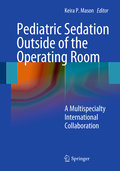
Pediatric sedation outside of the operating room: a multispecialty international collaboration
Mason, Keira P.
This comprehensive guide provides tips and instruction for the entire range of specialists that utilize pediatric sedation. Each specialty receives tailored coverage that focuses on its unique patient population, challenges, potential solutions, and sedation techniques. Each chapter is written by a leading specialist in the field. A comprehensive spectrum of pediatric sedation will be covered, which will be of interest to oncologists, pediatricians, hospitalists,intensivists, radiologists, emergency medicine specialists, anesthesiologists, nurses, dentists, and gastroenterologists. Background chapters cover pharmacology as well as pediatric anatomy, with special focus on the airway and respiratory mechanics. The future of pediatric sedation is also reviewed as well asthe cutting-edge research that is being done in the field. Comprehensive presentation of pediatric sedation across all specialties worldwide. Case studies of real-life difficult clinical situations International roster of leaders in sedation. Directed towards specialists in anesthesia, gastroenterology, oncology, radiology, internal medicine, nursing, hospital administration, pediatrics, dental, intensive care, emergency and hospital medicine. INDICE: Part I: Pediatric Sedation outside the Operating Room. 1.The History of Sedation. 2. Procedural Sedation.– Let's Review the Basics: The Pediatrician’s Perspective. 3. Sedation Policies, Recommendations and Guidelines Across the Specialties and Continents. 4.Sedation Scales and Discharge Criteria: How Do They Differ? Which One to Choose? Do They Really Apply to Sedation?- 5.Physiological Monitoring for Procedural Sedation: The Routine and Beyond. 6. The Pediatric Airway: Anatomy, Challenges, and Solutions. 7.Pediatric Physiology: How Does it Differ from Adults?- 8. Pharmacology and Clinical Application of Sedatives, Analgesics and Adjuncts. 9.Pharmacokinetics and Pharmacodynamics in the Pediatric Population. 10.Billing and Reimbursement for Sedation Services. Part II: Sedation Models Delivered by Different Specialties: A Global Voyage. 11.The Pediatric Hospital Medicine Service: Models, Protocols, and Challenges. 12.The Anesthesia Directed Sedation Service: Models, Protocols, and Challenges. 13.Sedation in the Intensive Care Unit: Challenges, Outcomes and Future Strategies. 14.Sedation for Pediatric Gastrointestinal Procedures. 15.Sedationin the Emergency Department: A Complex and Multifactorial Challenge. 16.Sedation of Pediatric Patients for Dental Procedures. 7. Pediatric Sedation: The European Experience and Approach. 18.Pediatric Sedation in the Underdeveloped Third World – An African Perspective: Models, Protocols, and Challenges. Part III: Safety in Sedation. 19.Pediatric Sedatives and the Food and Drug Administration (FDA): Challenges, Limitations, and Drugs in Development. 20. Incidence and Stratification of Adverse Events Associated with Sedation: Is there a Benchmark?- 21.Medicolegal Risks and Outcomes of Sedation. 22.Designing a Safe Pediatric Sedation Service: Adopting a New Culture. Part IV: Sedation into the 22nd Century. 23.Intravenous Infusions for Sedation: Rationale, State of the Art and Future Trends. 24.Usage of Complementary and Alternative Medicine in Pediatric Sedation. 25.Future of Pediatric Sedation. Index.
- ISBN: 978-0-387-09713-8
- Editorial: Springer New York
- Encuadernacion: Cartoné
- Páginas: 419
- Fecha Publicación: 28/08/2011
- Nº Volúmenes: 1
- Idioma: Inglés
